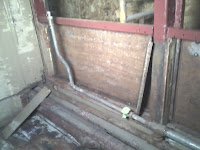And then I started assembling the last grid box. It's nearly complete, but I ran out of time before final adjustments could be made.
News and views of progress at the Illinois Railway Museum
Tuesday, February 23, 2016
Automatic Acceleration
And then I started assembling the last grid box. It's nearly complete, but I ran out of time before final adjustments could be made.
Posted by
Randall Hicks
at
8:24 PM
2
comments
![]()
Labels: 36 Progress
Thursday, February 18, 2016
Speaking of Motor Cars...
George Krambles wrote on the back:
Muscatine North & South RR (Burlington to Muscatine)
"Sarvent" model car of 1911
The Bettendorf Co. design, Bettendorf, Ia.
Built by Hicks Car & Loco Works, Chicago
Posted by
Randall Hicks
at
9:00 AM
5
comments
![]()
Labels: Krambles-Peterson Archive
Wednesday, February 17, 2016
More Painting


Posted by
Randall Hicks
at
7:08 PM
0
comments
![]()
Labels: 36 Progress
Tuesday, February 16, 2016
M-35 Report
Posted by
Randall Hicks
at
2:16 PM
0
comments
![]()
Labels: UP M-35
Saturday, February 13, 2016
The Last Grid Box
After he left, I had some time to start painting the floor inside the car. It had been heating up all day, for what that's worth.
This is just a first coat of primer, but it's a big improvement over the revolting red paint.
Posted by
Randall Hicks
at
8:24 PM
4
comments
![]()
Labels: 36 Progress
Friday, February 12, 2016
36 Report
Posted by
Randall Hicks
at
9:48 AM
2
comments
![]()
Labels: 36 Progress
Sunday, February 7, 2016
Streetcar to Ybor City
Ybor City is a historic district, somewhat like the French Quarter in New Orleans.


Posted by
Randall Hicks
at
6:19 PM
3
comments
![]()
Labels: Trip Reports
Saturday, February 6, 2016
Gates in Motion
And here's the control box. Mike Alterio did the very professional wiring job.
In the car shop, journal boxes for the 24 are being cleaned up. I should have gotten a better picture of him, but on the left is Jay Ellis, a new member. On the right is Dan Fenlaciki.
Out at the pit, you might never suspect work was going on.


Posted by
Randall Hicks
at
7:12 PM
4
comments
![]()
Labels: 36 Progress, Track Progress




















































